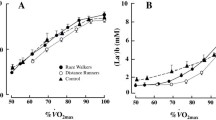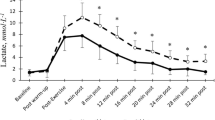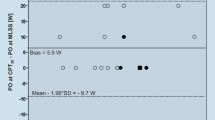Summary
The purpose of this study was to investigate the relationship between threshold points for heart rate (\({\text{TH}}_{f_c } \)) and blood lactate (Th1a) as determined by two objective mathematical models. The models used were the mono-segmental exponential (EXP) model of Hughson et al. and the log-log (LOG) model of Beaver et al. Inter-correlations of these threshold points and correlations with performance were also studied. Seventeen elite runners (mean, SD = 27.5, 6.5 years; 1.73, 0.05 m; 63.8, 7.3 kg; and maximum oxygen consumption of 67.8, 3.7 ml · kg−1 · min−1) performed two maximal multistage running field tests on a 183.9-m indoor track with inclined turns. The initial speed of 9 km · h−1 (2.5 m · s−1) was increased by 0.5 km · h−1 (0.14 m · s−1) every lap for thef c test and by 1 km · h−1 (0.28 m · s−1) every 4 min for the la test. After fitting the la or thef c data to the two mathematical models, the threshold speed was assessed in the LOG model from the intersection of the two linear segments (LOG-1a; LOG-f c) and in the EXP model from a tangent point (TI-1a; TI-f c). Th1a and\({\text{TH}}_{f_c } \) speeds computed with the two models were significantly different (P<0.001) and poorly correlated (LOG-1a vs LOG-f c:r=0.36, TI-1a vs TI-f c:r=0.13). In general,\({\text{TH}}_{f_c } \) were less well correlated with performance than Th1a. With two different objective mathematical models, this study has shown significant differences and poor correlations between Th1a and\({\text{TH}}_{f_c } \). Thus thef c inflection point with Conconi's protocol is a poor indicator of the la breakpoint with a conventional multistage protocol and a weaker indicator of running performance.
Similar content being viewed by others
References
Beaver W, Wasserman K, Whipp BJ (1985) Improved detection of lactate threshold during exercise using a log-log transformation. J Appl Physiol 59:1936–1940
Beaver WL, Wasserman K, Whipp BJ (1988) Blood lactate concentration in exercise. J Appl Physiol 64:1290–1291
Brooks GA (1986) Lactate production under fully aerobic conditions: the lactate shuttle during rest and exercise. Fed Proc 45:2924–2929
Bunc V, Heller J (1987) Kinetics of LA and VE during a physical load — use for assessing and checking of a training process. In: Tsopanakis A, Poortmans J (eds) Physiological biochemistry of exercise and training. Hellenic Sports Research Institute, Athens, pp 171–181
Bunc V, Bilec V, Karger P, Chlumsky J, Karger J, Bartosova S (1983) Ascertainment of the level of physical condition of basketball players by means of following the changes in lactate concentration in the blood. Theor Prax Tel Vych 31:563–567
Bunc V, Heller J, Novak J, Leso J (1985) Determination of the individual anaerobic threshold. Acta Univ Carol Gymn 21:73–81
Campbell ME, Hughson RL, Green HJ (1989) Continuous increase in blood lactate concentration during different ramp exercise protocols. J Appl Physiol 66:905–911
Cellini M, Vitiello P, Naglioti A, Ziglio PG, Martinelli S, Ballarin E, Conconi F (1986) Noninvasive determination of the anaerobic threshold in swimming. Int J Sports Med 7:347–351
Conconi F, Ferrari M, Ziglio PG, Droghetti P, Codeca L (1982) Determination of the anaerobic threshold by a noninvasive field test in runners. J Appl Physiol 52:869–873
Connett RJ, Honig CR, Gayeski TEJ, Brooks GA (1990) Defining hypoxia: a systems view of AssessingV 2 max in epidemiological studies: modification of the Astrand-Ryhming test2, glycolysis, energetics, and intracellularPO2. J Appl Physiol 68:833–842
Davies CTM (1968a) Limitations to the prediction of maximum oxygen intake from cardiac frequency measurements. J Appl Physiol 24:700–706
Davies CTM (1968b) Cardiac frequency in relation to aerobic capacity for work. Ergonomics 11:511–526
Droghetti P, Borsetto C, Casoni I, Cellini M, Ferrari M, Paolini AR, Ziglio PG, Conconi F (1985) Noninvasive determination of the anaerobic threshold in canoeing, cross-country skiing, cycling, roller, and ice skating, rowing and walking. Eur J Appl Physiol 53:299–303
Durnin JVGA, Womersley J (1974) Body fat assessed from body density and its estimation from skinfold thickness: measurements on 481 men and women aged from 16 to 77 years. Br J Nutr 32:77–97
Francis KT, McClatchey PR, Sumsion JR, Hansen DE (1989) The relationship between anaerobic threshold and heart rate linearity during cycle ergometry. Eur J Appl Physiol 59:273–277
Gaisl G, Wisspeiner G (1988) A noninvasive method of determining the anaerobic threshold in children. Int J Sports Med 9:41–44
Herren D, Charriere I, Howald H (1987) Conconi-Test and anaerobe Schwelle. Schweiz Z Sportmed 35:107–111
Hughson RL, Weisiger KH, Swanson GD (1987) Blood lactate concentration increases as a continuous function in progressive exercise. J Appl Physiol 62:1975–1981
Keul J, Simon G, Berg A, Dickhuth H-H, Goertler I, Kubel R (1979) Bestimmung der individuellen anaeroben Schwelle zur Leistungsbewertung und Trainingsgestaltung. Dtsch Z Sportmed 30:212–218
Kindermann W, Simon G, Keul J (1979) The significance of the aerobic-anaerobic transition for the determination of work load intensities during endurance training. Eur J Appl Physiol 42:25–34
Kuipers H, Keizer HA, Vries T de, Rijthoven P van, Wijts M (1988) Comparison of heart rate as a non-invasive determinant of the anaerobic threshold with the lactate threshold when cycling. Eur J Appl Physiol 58:303–306
Lacour JR, Padilla S, Denis C (1987) L'inflexion de la courbe fréquence cardiaque-puissance n'est pas un témoin du seuil anaérobie. Sci Motricité 1:3–6
Léger L, Thivierge M (1988) Heart rate monitors: validity, stability, and functionality. Phys Sportsmed 16:143–151
Léger L, Tokmakidis SP (1988) Use of the heart rate deflection point to assess the anaerobic threshold (letter). J Appl Physiol 64:1758–1759
Maffulli N, Sjodin B, Ekblom B (1987) A laboratory method for the non invasive anaerobic threshold determination. J Sports Med Phys Fitness 27:419–423
Maritz JS, Morrison JF, Peter J, Strydom NB, Wyndham CH (1961) A practical method of estimating an individual's maximal oxygen intake. Ergonomics 4:97–119
Oyono-Enguelle S, Marbach J, Heitz A, Ott C, Gartner M, Pape A, Vollmer JC, Freund H (1990) Lactate removal ability and graded exercise in humans. J Appl Physiol 68:905–911
Ribeiro JP, Fielding RA, Hughes V, Black A, Bochese MA, Knuttgen HG (1985) Heart rate break point coincides with the anaerobic and not the aerobic threshold. Int J Sports Med 6:220–224
Simon G, Berg A, Dickhuth H-H, Simon-Alt A, Keul J (1981) Bestimmung der anaerobes Schwelle in Abhängigkeit vom Alter und von der Leistungsfähigkeit. Dtsch Z Sportmed 32:7–14
Sjodin D, Jacobs I (1981) Onset of blood lactate accumulation and marathon running performance. Int J Sports Med 2:23–26
Stainsby WN, Brechue WF, O'Drobinak DM, Barcley JK (1989) Oxidation/reduction state of cytochrome oxidase during repetitive contractions. J Appl Physiol 67:2158–2162
Tokmakidis SP, Léger L (1988) External validity of the Conconi's heart rate anaerobic threshold as compared to the lactate threshold. In: Dotson CO, Humphrey JH (eds) Exercise physiology current selected research, vol 3. AMS Press, New York, pp 43–58
Wyndham CH, Strydom NB, Maritz JS, Morrison JF, Peter J, Potgieter ZU (1959) Maximum oxygen intake and maximum heart rate during strenuous work. J Appl Physiol 14:927–936
Yeh MP, Gardner RM, Adams TD, Yanowitz FG, Crapo RO (1983) “Anaerobic threshold”: problems of determination and validation. J Appl Physiol 55:1178–1186
Author information
Authors and Affiliations
Rights and permissions
About this article
Cite this article
Tokmakidis, S.P., Léger, L.A. Comparison of mathematically determined blood lactate and heart rate “threshold” points and relationship with performance. Europ. J. Appl. Physiol. 64, 309–317 (1992). https://doi.org/10.1007/BF00636217
Accepted:
Issue Date:
DOI: https://doi.org/10.1007/BF00636217




